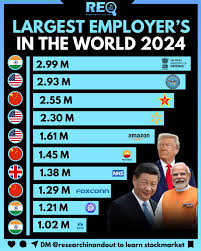
The global workforce landscape in 2024 continued to be dominated by a mix of retail giants, government institutions, state-owned enterprises, and technology-driven companies.
These organizations employ millions of people worldwide, reflecting not only their economic might but also their critical role in providing essential services and products to societies.
From multinational corporations like Walmart and Amazon to government institutions such as the Indian Ministry of Defense and the U.S. Department of Defense, the list of the largest employers highlights the diverse nature of workforces shaping the global economy.
Retail powerhouse Walmart remains the world’s leading private-sector employer with an estimated 2.2 million employees. With operations across the United States and numerous international markets, Walmart’s workforce underpins its vast retail network and growing e-commerce presence, according to Global Statistics.
Similarly, Amazon has expanded its employee base to about 1.5 million, driven by the continuous growth of online shopping, cloud computing through Amazon Web Services, and logistics infrastructure.
These two American giants illustrate the centrality of consumer retail and technology in the modern labor market.
China, with its vast population and expansive state-owned enterprises, also dominates the list of top employers.
The State Grid Corporation of China, employing more than 1.3 million people, plays a critical role in powering the country’s energy needs, overseeing infrastructure vital for national development.
Likewise, the China National Petroleum Corporation (CNPC), with over 1 million employees, is a cornerstone of the global energy sector, spanning exploration, production, and refining.
Together, these companies highlight China’s reliance on large-scale human resources to manage energy and infrastructure on a national scale.
Government institutions and military organizations remain among the world’s largest employers as well. The Indian Ministry of Defense tops the list globally, employing nearly 3 million personnel, reflecting the scale of India’s armed forces and supporting staff.
People’s Liberation Army (PLA) of China, with more than 2.5 million members, underscores the size of China’s military establishment.
Meanwhile, the U.S. Department of Defense, with close to 3 million employees, including military and civilian staff, continues to be one of the largest employers worldwide.
These institutions demonstrate how defense and national security are not only matters of policy but also of vast employment structures. Beyond governments and retail, manufacturing and healthcare also feature prominently.
Taiwanese manufacturer Hon Hai Precision Industry (Foxconn) employs over 1.2 million workers, many of whom are engaged in producing electronics for global brands such as Apple.
In the United Kingdom, the National Health Service (NHS) remains one of the largest healthcare employers with around 1.3 million staff, underlining the scale of labor required to sustain universal healthcare systems.
Companies such as BYD in China and Tata Group in India also reflect the growing importance of industrial and automotive sectors in creating large-scale employment opportunities.
Taken together, the world’s largest employers in 2024 demonstrate a balance between private enterprise, government organizations, and state-owned corporations.
While technology and retail giants continue to expand their influence, traditional sectors such as energy, defense, healthcare, and manufacturing remain critical pillars of global employment.
These organizations not only provide livelihoods for millions but also shape the economic, social, and political fabric of the 21st century.
Follow The Times Kuwait on X, Instagram and Facebook for the latest news updates












